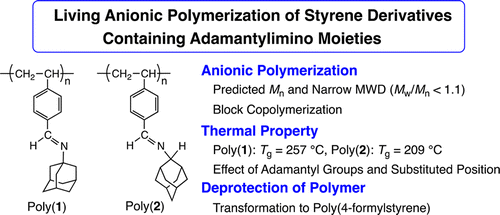当前位置:
X-MOL 学术
›
Macromolecules
›
论文详情
Our official English website, www.x-mol.net, welcomes your
feedback! (Note: you will need to create a separate account there.)
Living Anionic Polymerization of N-(1-Adamantyl)-N-4-vinylbenzylideneamine and N-(2-Adamantyl)-N-4-vinylbenzylideneamine: Effects of Adamantyl Groups on Polymerization Behaviors and Thermal Properties
Macromolecules ( IF 5.1 ) Pub Date : 2015-11-23 00:00:00 , DOI: 10.1021/acs.macromol.5b02075 Beom-Goo Kang 1 , Hideo Shoji 2 , Hiroshi Kataoka 2 , Reo Kurashima 2 , Jae-Suk Lee 3 , Takashi Ishizone 2
Macromolecules ( IF 5.1 ) Pub Date : 2015-11-23 00:00:00 , DOI: 10.1021/acs.macromol.5b02075 Beom-Goo Kang 1 , Hideo Shoji 2 , Hiroshi Kataoka 2 , Reo Kurashima 2 , Jae-Suk Lee 3 , Takashi Ishizone 2
Affiliation

|
The anionic polymerization of N-(1-adamantyl)-N-4-vinylbenzylideneamine (1) and N-(2-adamantyl)-N-4-vinylbenzylideneamine (2) was performed using various initiators, such as oligo(α-methylstyryl)dipotassium, potassium naphthalenide, diphenylmethylpotassium, and diphenylmethyllithium, in THF at −78 °C for 1 h to investigate the effects of adamantyl groups on the polymerization behaviors and thermal properties of the resulting polymers. The well-defined poly(1) and poly(2) with predictable molecular weights and narrow molecular weight distributions were successfully obtained, indicating that the bulky adamantyl groups effectively protected the carbon–nitrogen double bond (C═N) from the nucleophilic attack of the initiators and the propagating chain ends. The stability of the propagating chain end of poly(1) was confirmed by the quantitative efficiencies in the postpolymerization and the sequential copolymerization with tert-butyl methacrylate. A poly(4-formylstyrene) was quantitatively formed by the acidic hydrolysis reaction of the N-adamantylimino groups of the poly(1). The resulting poly(1) and poly(2) showed significantly high glass transition temperatures (Tg) at 257 and 209 °C, respectively, due to the bulky and stiff adamantyl substituents. It was also found that the substituted position of adamantane unit and the linkage between polystyrene backbone and adamantyl groups played very important roles to determine the Tg values of the substituted polystyrenes.
中文翻译:

N-(1-金刚烷基)-N -4-乙烯基苄叉亚胺和N-(2-金刚烷基)-N -4-乙烯基苄叉胺的活性阴离子聚合:金刚烷基对聚合行为和热性能的影响
N-(1-金刚烷基)-N -4-乙烯基苄叉亚胺(1)和N-(2-金刚烷基)-N -4-乙烯基苄叉胺(2)的阴离子聚合反应是使用各种引发剂如低聚(α-甲基苯乙烯基)进行的),-萘二甲酸钾,萘二甲酸钾,二苯基甲基钾和二苯基甲基锂在THF中于-78°C放置1小时,以研究金刚烷基对所得聚合物的聚合行为和热性能的影响。定义明确的poly(1)和poly(2)具有可预测的分子量,并且分子量分布窄,这表明庞大的金刚烷基基团有效保护了碳-氮双键(C═N)免受引发剂和正在传播的链端的亲核攻击。通过与甲基丙烯酸叔丁酯的后聚合和顺序共聚中的定量效率,证实了poly(1)的增长的链端的稳定性。通过聚(1)的N-金刚烷基氨基的酸性水解反应定量地形成聚(4-甲酰基苯乙烯)。所得的poly(1)和poly(2)由于笨重和刚性的金刚烷基取代基,分别在257和209°C下显示出很高的玻璃化转变温度(T g)。还发现金刚烷单元的取代位置以及聚苯乙烯主链与金刚烷基之间的连接对于确定取代的聚苯乙烯的T g值起非常重要的作用。
更新日期:2015-11-23
中文翻译:

N-(1-金刚烷基)-N -4-乙烯基苄叉亚胺和N-(2-金刚烷基)-N -4-乙烯基苄叉胺的活性阴离子聚合:金刚烷基对聚合行为和热性能的影响
N-(1-金刚烷基)-N -4-乙烯基苄叉亚胺(1)和N-(2-金刚烷基)-N -4-乙烯基苄叉胺(2)的阴离子聚合反应是使用各种引发剂如低聚(α-甲基苯乙烯基)进行的),-萘二甲酸钾,萘二甲酸钾,二苯基甲基钾和二苯基甲基锂在THF中于-78°C放置1小时,以研究金刚烷基对所得聚合物的聚合行为和热性能的影响。定义明确的poly(1)和poly(2)具有可预测的分子量,并且分子量分布窄,这表明庞大的金刚烷基基团有效保护了碳-氮双键(C═N)免受引发剂和正在传播的链端的亲核攻击。通过与甲基丙烯酸叔丁酯的后聚合和顺序共聚中的定量效率,证实了poly(1)的增长的链端的稳定性。通过聚(1)的N-金刚烷基氨基的酸性水解反应定量地形成聚(4-甲酰基苯乙烯)。所得的poly(1)和poly(2)由于笨重和刚性的金刚烷基取代基,分别在257和209°C下显示出很高的玻璃化转变温度(T g)。还发现金刚烷单元的取代位置以及聚苯乙烯主链与金刚烷基之间的连接对于确定取代的聚苯乙烯的T g值起非常重要的作用。











































 京公网安备 11010802027423号
京公网安备 11010802027423号